Donald Pleasence
(Jim Dougall)
Carol Kane
(Jeannie Dougall)
Doris Petrie
(Mary Dougall)
Leo Phillips
(Sandy)
Paul Bradley
(Jimmie
Dougall)
Doug McGrath
(Billy)
Christine
Thomas
(Sarah)
Bonnie Carol
Case
(Dollie)
Director:
William
Fruet
Screenplay:
William
Fruet
Based on the
play by:
William
Fruet
Producer:
John
Vidette
1972 Canadian Film Awards:
---Best Film (award won
by John Vidette)
---Best Supporting Actress (award won by Doris Petrie)
---Art Direction (award won
by Karen Bromley)
Fine performances in sad tale of girl impregnated by brother's drunken pal during WW2 and her father's efforts to save the family's honor.
---LEONARD MALTIN'S MOVIE & VIDEO GUIDE
Sad, glum way to spend an evening. Kane is good in a non-comic role.
---VIDEO HOUND'S GOLDEN MOVIE RETRIEVER
AMAZON.COM: Popular online seller offers the video in NTSC format. A DVD is also offered in Region 1 format.
BEST VIDEO: Rental service allows US customers to rent the Region 1 DVD by mail.
THE CAROL KANE UNOFFICIAL FAN PAGE: Glenn Abernathy's fan shrine devoted to the stage/screen actress with a biography, articles, filmography, and television schedule.
DVD TALK: Don Huston reviews Somerville House Releasing / Ventura Distribution's Region 1 DVD at this resource for DVD movie news, reviews, and talk.
DVD VERDICT: Judge Barrie Maxwell reviews Somerville House Releasing / Ventura Distribution's Region 1 DVD at this DVD review web site which, according to its slogan, strives to deliver "truth, justice, and the digital way."
THE INTERNET MOVIE DATABASE: Cast and crew information is available at this popular film database.

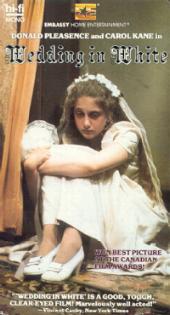
William Fruet's Wedding in White is a good, tough, clear-eyed Canadian film about a working-class family and the sweet, dim-witted, 16-year-old daughter, Jeannie, who finds herself "in trouble" (the euphemism she favors) after a singularly quick and joyless seduction by her brother's best friend.
The time is midway through
World War II, when being in trouble meant instant disgrace, especially
to a father like Jeannie's, a hard-working, hard-drinking, narrow-minded
man who would say that boys will be boys but that the girls 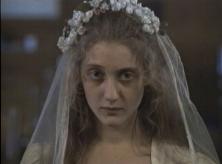 who do are whores. His solution: marry Jeannie
off to his best friend Sandy, a robust Scot of about 60 who is
a drunk.
who do are whores. His solution: marry Jeannie
off to his best friend Sandy, a robust Scot of about 60 who is
a drunk.
Wedding in White is the sort of domestic drama that most playwrights and filmmakers botch, either because they determinedly explain away the characters as sociological phenomena, as in another Canadian film, Goin' Down the Road, or because they invest the characters with inclinations to doggedly banal self-analysis. People in plays like Robert Anderson's I Never Sang for My Father and Frank Gilroy's The Subject Was Roses tend to talk about themselves as if they were not there, and to conceptualize problems that in life, arguing by the kitchen sink, remain specific.
Mr. Fruet, who wrote the screenplay for Goin' Down the Road, directed Wedding in White and adapted the script from his stage play. The dialogue is so faultless that even the slang defines the era as much as the skirt lengths and the automobiles. "My dad would crown me if I did that," Jeannie says at one point. More important, never does the writer-director allow his characters to talk above their station, to describe the overview that we in the audience can see for ourselves.
Wedding in White is not really tragic, nor is it as
bleak as it might sound. It is a closely observed chronicle of
one family's life, moving and funny and a little 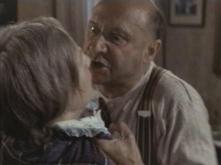 scary,
full of unexpected stoicism and the kind of boozy jocularity
that can suddenly erupt into violence. It is also marvelously
well acted.
scary,
full of unexpected stoicism and the kind of boozy jocularity
that can suddenly erupt into violence. It is also marvelously
well acted.
Donald Pleasence is Jeannie's dad, "a top-notch bowler and a triple-threat man at darts," who also manages to suggest the existence of evil in the most commonplace of personalities. Jeannie's mother is played by Doris Petrie, a Canadian actress of unaffected beauty and great discretion of gesture. Also fine are Paul Bradley and Doug McGrath (the born losers of Goin' Down the Road), as, respectively, the soldier son and the best friend who so casually gets Jeannie into trouble.
At the center of the film, looking oddly like a Jan van Eyck subject transplanted to a land of five-and-tens and drug stores, is Carol Kane, whose Jeannie is someone obviously destined to go through life with nothing ever fitting.
When her father brings home a second-hand-dress for her to wear to the wedding she doesn't want, Jeannie's first thought is to call her friend Dollie, as if she had just received a birthday present. The world, the passions of others, her clothes, even her masses of frizzy reddish hair, are too big for her, and her brain is too small.
Wedding in White opened yesterday at the Little Carnegie.
From the April 30, 1973
edition of THE
NEW YORK TIMES.
Review © 1973 THE
NEW YORK TIMES. All Rights Reserved.
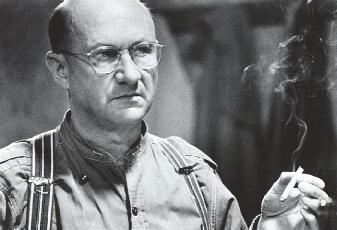
A working-class home in Canada during World War II. A son returns unexpectedly on a weekend pass, with an Army buddy, and his somewhat dim parents are thoroughly delighted. The welcoming scene in the doorway is one of conventional jocularity, setting an extra place for dinner, and who's going to carry which parcels upstairs.
Amid the overlapping shouting
and backslapping there is a quiet space, occupied and defined
by the soldier's teen-aged sister, Jeannie. Wearing 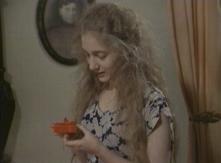 frizzed
out red hair, a Van Eyck face filled with a long nose, and a
flowered dress too large for her skinny frame, Jeannie looks
bewildered.
frizzed
out red hair, a Van Eyck face filled with a long nose, and a
flowered dress too large for her skinny frame, Jeannie looks
bewildered.
Her brother has just tossed her a small gift, a rhinestone brooch, barely breaking stride in boisterous babble with his father and friend. And Jeannie, the eye in this "welcome home" storm, is trying to recognize her reaction to the gift. She doesn't speak; she simply looks at the gift and at each person, her head moving in dashes from talking person to person.
Not only is she having difficulty appreciating the gift -- obviously she doesn't get too many, and, when you think about it, gifts are strange -- she is also trying to understand what her mother, father, brother, and friend are saying. But as she listens to one, another interrupts, breaking her concentration. Thus Jeannie is alone with her silence.
William Fruet's Wedding in White, a prize-winning Canadian film, is about a world divided into the noise-makers and the quiet, the aggressive and the deferring. And as this beautifully acted film progresses, we notice the noise-makers and louts are men, that the silent and deferring are women.
With its period setting and
working-class dialog Wedding in White is anything
but a stentorian women's lib essay; however, its meaning could
not be more 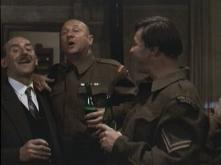 plain, what with
a story line that has Jeannie raped by her brother's Army buddy,
become pregnant, and presumed to be a whore by her "jolly
good fellow" father.
plain, what with
a story line that has Jeannie raped by her brother's Army buddy,
become pregnant, and presumed to be a whore by her "jolly
good fellow" father.
What makes the antimale presentation palatable is that the men in Wedding appear as trapped in their roles as their women. Late in the film a half-dozen village menfolk are getting sprawling drunk in Jeannie's dining room while their wives sit wrapped in wool suits on a nearby sofa. The women would no more think of chugging a bottle of ale than would the men consider sitting demurely on a divan.
Though it veers off into an unbelievable conclusion, Wedding in White is blessed with memorable performances by its eight characters. It is the rare film, and The Last Picture Show is a recent example, that presents its secondary characters with as much clarity as its stars. Wedding in White contains no small parts or performances, and that accounts for it holding our attention while delivering a contemporary message.
Review © 1973 THE CHICAGO TRIBUNE. All Rights Reserved.
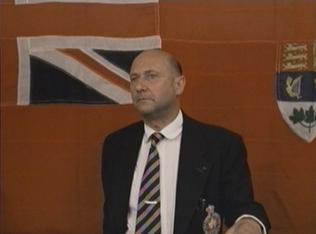
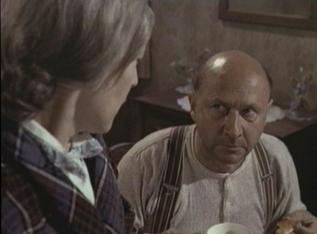
Photos © 1972 DERMET PRODUCTIONS LIMITED. All Rights Reserved.
Video artwork © 1986 EMBASSY HOME ENTERTAINMENT. All Rights Reserved.

[ FILMS | HOME ]